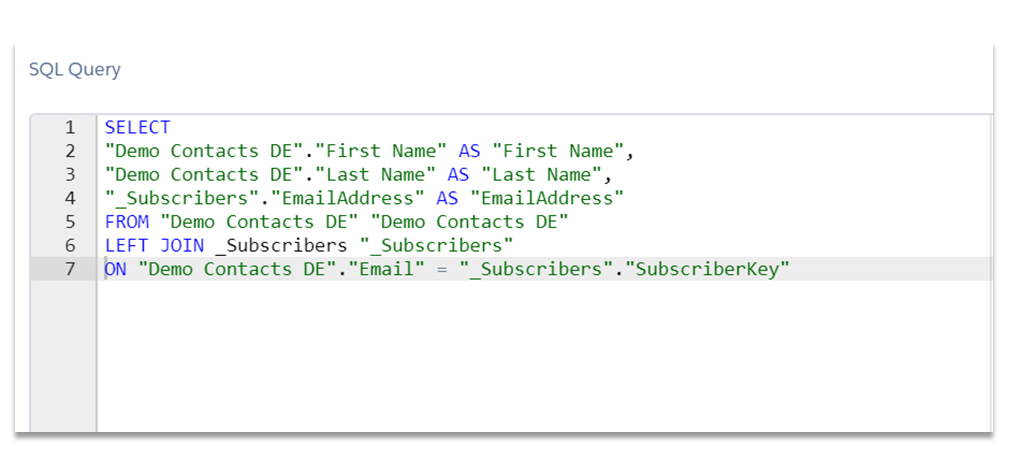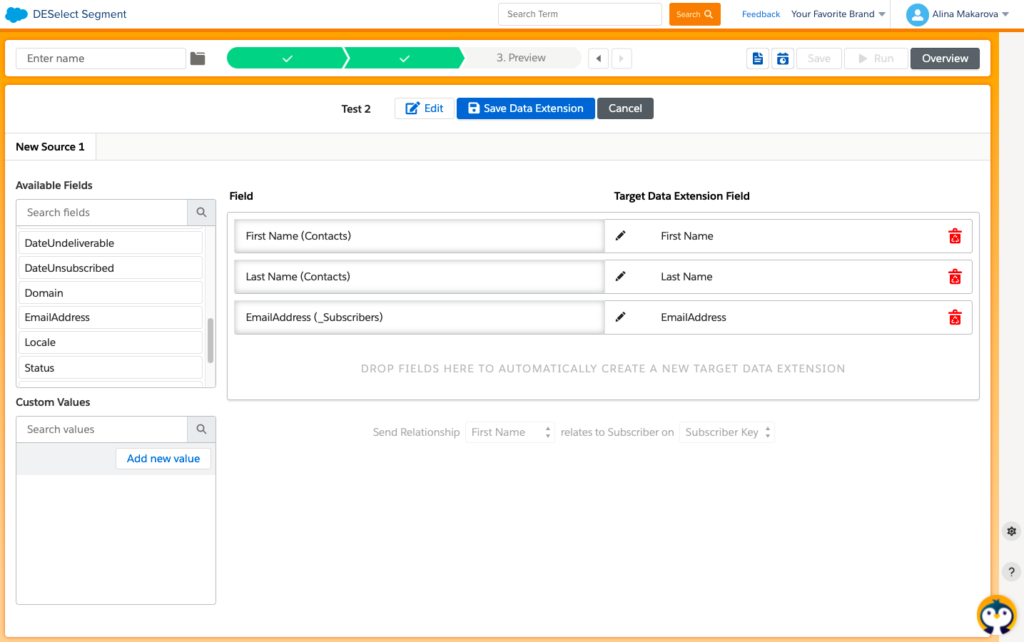
Data views are system-generated tables (or “data extensions, DEs”) in Salesforce Marketing Cloud (SFMC). They contain different information about the subscribers and events such as email/SMS sends, email opens, or links clicked. You can also view behavioral information such as emails that are forwarded to friends. There are 24 different data views in SFMC that you can check out here.
In this article, We would like to show how you can segment data views using SQL in SFMC and to compare this process with segmenting on data views using DESelect. In both cases, we would like to query on contacts that are known Subscribers, using the data view “_Subscribers”.
For the purpose of this article, we are using the demo data available to partners and clients. Moreover, we have created several scenarios of use cases that you can try out using our demo data on our Support Portal.
How to query the ‘_Subcribers’ data view with SQL in Salesforce Marketing Cloud (SFMC)?
First of all, you need to be sure that your access to data views has been enabled. Then, you have to create a target data extension (DE) where the information will be stored. In this case, you create a simple DE with 3 fields, namely, First Name, Last Name, Email Address.

Next, you need to go to Automation Studio to create an SQL Query Activity.
- Select the DE which contains your Contacts’ information. As mentioned earlier, we are using our own demo data, so in this case we take the data extension named “Demo Contacts DE”.
- Choose the fields that you want to see in your target DE, and rename them if necessary (e.g. First Name” AS “First Name”, “Last Name” AS “Last Name”).
Then, you have to choose the data view “_Subscribers”, field “EmailAdress” and rename it if necessary.
- Choose the FROM criteria, where you select your initial DE (e.g. “Demo Contacts DE”)
- Choose the relationship between the DE and the data view using JOINS. In this case, we are using the LEFT JOIN between “Email” from Contacts and “SubscriberKey” from _Subscribers
- Choose your target DE, the one you created in advance
- Save and Run your Query activity
- Review your result in the target DE

How to query on '_Subcribers' using data views with DESelect?
DESelect is an addon for Salesforce Marketing Cloud (SFMC) that makes the lives of marketers easier. How? With DESelect you don’t have to bother learning how to use SQL to create a segmented campaign, which means that you save precious time getting your campaign up and running!
In order to query on “_Subcribers” using data views in DESelect you simply have to:
- Choose to create a “New Selection” in DESelect.
- From the data extensions (DEs) on the left choose your initial DE and drag-and-drop to the right. As mentioned earlier, we are using our own demo data, so in this case, we take the data extension named “Demo Contacts DE”.
- Choose the data view “_Subscribers”.
Note: DESelect supports all 24 data views, which can be easily recognized as their name starts with an underscore in the ‘Available Data Extensions’ section.
- Choose a relationship between them, in this case, we match Contacts WITH/WITHOUT MATCHING _Subscribers, where we choose the “Email” field of Contact to relate to the “SubscriberKey” in _Subscribers

- Next, we create a target DE on the fly, no preparation in advance is necessary.
- Here we choose the fields that we want to see in our target DE: First Name, Last Name, Email Address.
- We select First Name and Last Name from our DE and Email Address from the data view.
- Drag-and-drop or double click to add the fields to the target DE.

- Next, hit “Preview” to check if the data has been created correctly.
- If you are satisfied with the results click “Run” to populate your target DE with the right data.
Conclusion
Data views enable you to do advanced segmentation in Salesforce Marketing Cloud (SFMC) using their current 24 variations. However, it also means that your knowledge of SQL has to be good enough to create queries that contain not only multiple data extensions (DEs), but also data views. Although SQL offers a lot of flexibility, chances are that you’d be spending a lot of time on this to get the perfect segment. Using DESelect, you don’t have to use any SQL at all, since all you have to do is drag-and-drop to build your ideal segment within minutes.
- How to query the ‘_Subcribers’ data view with SQL in Salesforce Marketing Cloud (SFMC)?
- How to query on '_Subcribers' using data views with DESelect?
- Conclusion
Latest Articles
-
A Practical Salesforce Implementation Guide
A Practical Salesforce Implementation Guide Implementing Salesforce isn’t just about installing software. It’s about getting your systems, teams, and data aligned to support better customer experiences and business results. When done right, a Salesforce implementation can boost efficiency, support growth, and provide a clearer view of your customers. Our Salesforce implementation guide walks you through […]September 3, 2025SalesForce Contact Builder
Making Sense of Salesforce Contact Builder Salesforce Contact Builder is the engine that helps bring customer data together inside Marketing Cloud. If you want to send the right message to the right person at the right time, this is where it all starts. Contact Builder allows marketers to collect, organise, and connect contact data from […]July 30, 2025How Consumer Brands Can Avoid Email Overload and Choice Paralysis
How Consumer Brands Can Avoid Email Overload and Choice Paralysis Consumer brands operating multiple labels under one corporate umbrella often face a unique set of challenges when it comes to email marketing, particularly when a large multibrand company attempts to manage email campaigns across its various brands simultaneously. One of the biggest pitfalls is overwhelming potential buyers […]July 29, 2025Crafting Channel-Based Buyer Segments: Unlocking Seamless Offline and Online Marketing
Crafting Channel-Based Buyer Segments: Unlocking Seamless Offline and Online Marketing To effectively segment buyers by their preferred marketing channels, while balancing both offline and online behaviors, consumer brands must move beyond generic audience buckets and directly analyze when, where, and how customers interact and purchase. Here’s a targeted approach to building actionable channel-based segments, with […]July 29, 2025Join our newsletter to receive updates and helpful SFMC guides.









